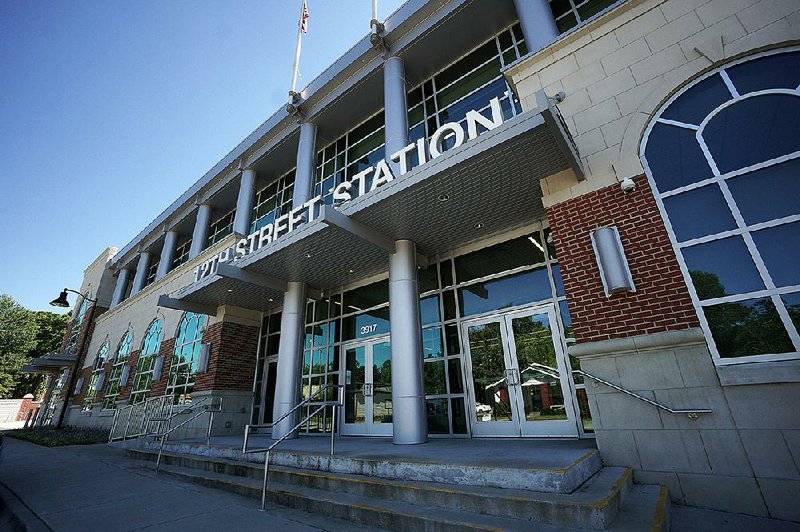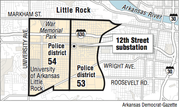From the driveway of her Little Rock home, Debra Finley could see the police substation and its brightly lit sign glowing in the dark.
It was a May night and people had gathered outside the crime-scene tape on 11th Street -- one block away from the Little Rock Police Department's 12th Street substation.
Next door to Finley's house, police were investigating the city's 12th homicide of the year. Earlier that day, police had found Gwenda Moorman dead in her kitchen at 3914 W. 11th St. She had been fatally stabbed, police would later say.
Interviewed weeks later, Finley said of the substation: "I really thought it would help the crime rate in this area, but [criminals] don't care; they're not scared."
In Moorman's death, police quickly arrested Michael DeWayne Gardner, 44. He has pleaded innocent to a charge of capital murder.
Finley's concerns are shared by other residents in the vicinity of the city's 44,000-square-foot police station located on West 12th Street.
For Finley and her neighbors, the reality of the station's presence has not matched their expectations. With police so close, they thought it would help deter crime.
But city officials say the substation should not be seen as a fix-all for problems in the 12th Street corridor.
Opened in September 2014, the 12th Street substation was designed as a mixed-use building that would attract private-sector investment to the community by leasing space to businesses, City Director Ken Richardson, who represents Ward 2, said at the time.
Richardson said the building was designed to improve community relations by creating a space that allowed residents and officers to interact, unlike the typical substation the city had planned to build before he was elected.
Today, the $12.5 million building sits near two of Little Rock's most active downtown patrol areas -- District 53 and District 54.
The number of violent crimes reported in District 54 increased more than 85 percent from 2012 to 2015, according to Police Department data. The total number of reported crimes in the district has also increased slightly, from 960 reported in 2012 to 1,047 in 2015, according to the data.
District 53 has fared better over that period. Reports of crime, including violent crime, have fallen more than 20 percent from 2012-15 in the district.
Capt. Marcus Paxton oversees police operations at the 12th Street substation. At the beginning of this year, Paxton said he picked Districts 53 and 54 as priority districts because of their higher rates of violent crimes.
Paxton said they have seen some progress this year.
He points to data that show a 24 percent drop in the number of reported crimes in District 54 so far this year compared with last year's numbers through early September. District 53 shows a 1 percent increase in criminal reports during the same period, according to police data.
Finley, who lives on West 11th Street, said it does seem that officers respond more quickly to calls.
"They have a lot of areas that they patrol, and they really are doing the best they can," she said.
Paxton said the building makes it easier for residents to contact police directly because of its location. Hopefully, he said, it makes people feel more comfortable reporting crime to police.
But, he said the police presence can only do so much.
"I don't think a building alone will stop crime," he said. "It's going to be a combination of relationships between the police and the community."
Police have hosted a number of events at the station to engage the public and encourage communication between police and the community, he said. Paxton said the 12th Street substation has hosted blood drives, quarterly crime statistics meetings and drug drop-off programs. Neighborhood associations have also held meetings at the station, he said.
"We're trying to build relationships, and that's what it's all about," Paxton said.
Yet, Leon Tolbert, who lives about a block away from the station, said there's still a disconnect on the street between police and residents.
Tolbert called for more community policing and said he rarely sees officers trying to get to know residents in his community.
Like other residents, Tolbert said he thought the station in his neighborhood would deter criminals and have a positive impact.
"I was really disappointed," he said. "It turned out to be a dud more than anything."
Freddie Phillips, 70, lives about a block away from the 12th Street substation. She moved to her house on West 12th Street in February, comforted by the fact that she lived within walking distance of a big police station.
But her patio furniture was stolen in broad daylight this summer, a sign to her that the police presence has not done much to stop crime.
Her granddaughter, Stephanie Ravion, who also lives at the house, said officers do not engage with residents and only seem to roll through neighborhoods while out on patrol.
"I've never seen one outside of the car," she said.
There's too many liquor stores, she said, and not enough community programs to help get people on their feet.
She said there's a sense of hopelessness to many people who wander the streets, dealing with substance abuse and the lack of job opportunities.
Richardson said he has seen a similar trend in the community -- some young people with a dangerous combination of hopelessness and fearlessness that can lead to crime.
He said there is a high number of disconnected adults and youths in the 12th Street corridor, people ground down by educational problems, substance abuse and joblessness, he said.
It would be unrealistic, Richardson said, to expect a police presence alone to erase all of the issues that contribute to criminal activity.
Vacant homes, he said, become magnets for criminal activity in neighborhoods, and the 12th Street corridor has a lack of healthy food options.
"That area is a financial and a food desert," he said.
Metro on 09/12/2016

